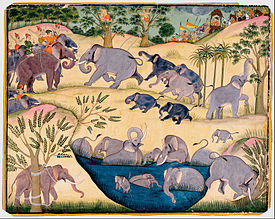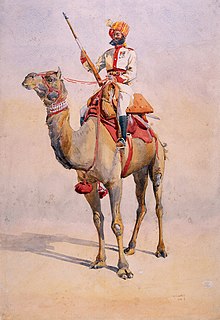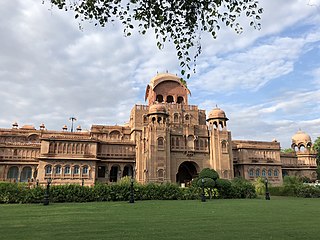
Bikaner is a city in the northwest of the state of Rajasthan, India. It is located 330 kilometres (205 mi) northwest of the state capital, Jaipur. Bikaner city is the administrative headquarters of Bikaner District and Bikaner division.

Rao Jodha was the 15th Rajput chief of Rathore clan who ruled the Kingdom of Marwar in the present-day state of Rajasthan. He was the fifth son of Rao Ranmal. He is known for his illustrious military career and for founding the city of Jodhpur in 1459, which subsequently became the new capital of Marwar after Mandore.
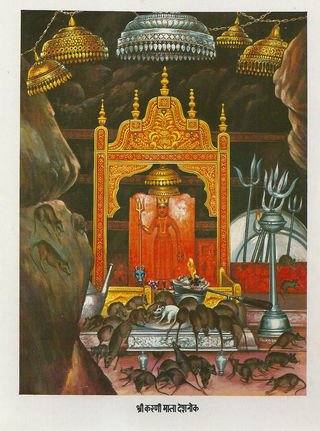
Karni Mata, known by various names such as Bhagwati, Mehaai, Jagdamba, and Kiniyani is a Hindu Goddess of power and victory described as a warrior sage, who lived between 14th and 16th centuries in Western Rajasthan. Karni Mata is the tutelary deity of the Rajputs and Charans of northwestern India. As a Sagati, she is also worshipped as an incarnation of Hinglaj or Durga. She is the official deity of the royal families of Bikaner and Jodhpur. Karniji played an important role in shaping the history of the region. She is intimately associated with the establishment of the Rajput hegemony in the region. With her blessings, Rao Jodha and Rao Bika founded the kingdoms of Jodhpur and Bikaner. At the request of the Maharajas of Bikaner and Jodhpur, she laid the foundations of Bikaner Fort and Mehrangarh Fort, the two most important forts in the region. She lived an ascetic life and was widely revered during her lifetime. Indian Army troops from the Marwar region also regard Karni Mata as their patron deity.
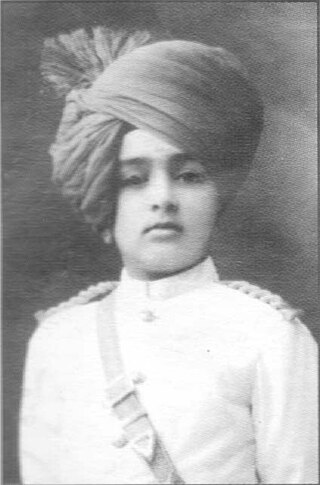
Maharaja Karni Singh ji , also known as Dr Karni Singh, was from 1950 the last Maharaja of Bikaner State to hold the title of Maharaja of Bikaner, officially, until 1971, when the privy purse and all the royal titles were abolished by the Republic of India. He was also a politician, serving as a member of the Lok Sabha for twenty-five years, from 1952 to 1977, and an international clay pigeon and skeet champion.

Junagarh Fort is a fort in the city of Bikaner, Rajasthan, India. Raja Dhaj, Ror Kumar, ruled over the principality of Junagarh in the fifth century BC. The fort was originally called Chintamani and was renamed Junagarh or "Old Fort" in the early 20th century when the ruling family moved to Lalgarh Palace outside the fort limits. It is one of the few major forts in Rajasthan which is not built on a hilltop. The modern city of Bikaner has developed around the fort.

The region of Bikaner, stretching across north-western state of Rajasthan in India, was earlier known as Jangladesh. It included the present-day districts of Bikaner, Churu, Ganganagar, and Hanumangarh. It is bounded on the south by Marwar and Jaisalmer regions, on the east by Ajmer-Merwara region.
The Dalpat Vilas is the surviving fragment of a historical manuscript. Written in the Rajasthani language, it is the earliest known Charan source of Mughal-Rajput relations. The initial portion of the manuscript covers the genealogy of the Rathores and the Sur dynasty. The bulk of the manuscript chronicles events in Marwar and adjoining areas during the reign of Akbar.
Mehta is an Indian surname, derived from the Sanskrit word mahita meaning 'great' or 'praised'. It is found among several Indian religious groups, including Hindus, Jains, Parsis, and Sikhs. Among Hindus, it is used by a wide range of castes and social groups, including Khatris, Rajputs, Brahmins and Banias. Mehta is also a common surname found among the Koeri caste of Bihar, who are commonly known as Kushwaha.

Jangladesh, also known as Janglu, was a historical region in north, north-western and north-eastern Rajasthan state in northern India. It included the present-day districts of Bikaner, Churu, Ganganagar, and Hanumangarh. It was bounded on the south by Marwar and Jaisalmer regions, on the east by Ajmer-Merwara region.

Kingdom of Marwar, also known as the Jodhpur State under the British, was a kingdom in the Marwar region from 1243 to 1818 and a princely state under British rule from 1818 to 1947. It was established in Pali by Rao Siha, possibly a migrant Gahadavala noble, in 1243. His successors continued to struggle against regional powers for domination and 9 out of 15 rulers till 1438 died in combat. In 1395, its capital was changed to Mandore by Rao Chunda of Mandore and to Jodhpur in 1459 by Rao Jodha.

Rawat Kandhal, the third son of Rao Ranmal, was the founder of the Kandhalot clan of the Rathore dynasty in Northern India, and the co-founder of the kingdoms of Bikaner and Marwar.

Karamchand Bachhawat (1542-1607) (विभूति) was the Dewan, Prime Minister of Bikaner State in the former Rajputana from 1571 to 1591. Karamchand, a descendant of Bachhraj, was a valiant warrior, a good administrator and a strategist in Bikaner and had a good relationship with Akbar. In 1591, fearing for his life, he resigned. At Akbar's invitation, Karamchand later joined the emperor as an adviser to the Lahore court.
Rao Lunkaran was the third Rathore Rajput ruler of Bikaner, ruling from 1505 to 1526. He spent much of his two-decade long reign consolidating and expanding the territories of his relatively new Kingdom of Bikaner.
Delwara, nestled in the Aravalli Range hills, is a small town about 28 kms away from Udaipur, Mewar, and close to Eklingji Temple, on the way to the temple town of Nathdwara, in the state of Rajasthan, India. Delwara was originally known as ‘Devkul Patan Nagri’, which means the town of god. It boasted over 1500 temples at one time, out of which there were over 400 Jain temples. Delwara was the center of learning and culture before the 15th century AD. Around the middle of the 13th century, Raja Sagar, a Deora Chauhan and a descendant of Rao Kirtipal of Jalore, was a very brave king of Delwara (Mewar). Descendants of Raja Sagar sacrificed their lives whilst fighting alongside Ranas of Mewar against Muslim invaders. Raja Sagar was the progenitor of Bachhawat and Bothra clan of Oswals. Sagar's son, Kunwar Bohitya was immensely influenced and inspired by Jain philosophy. Samdhar, a grandson of Bohitya and a Deora Chauhan, was the first man in his genealogy to convert to Jainism.


